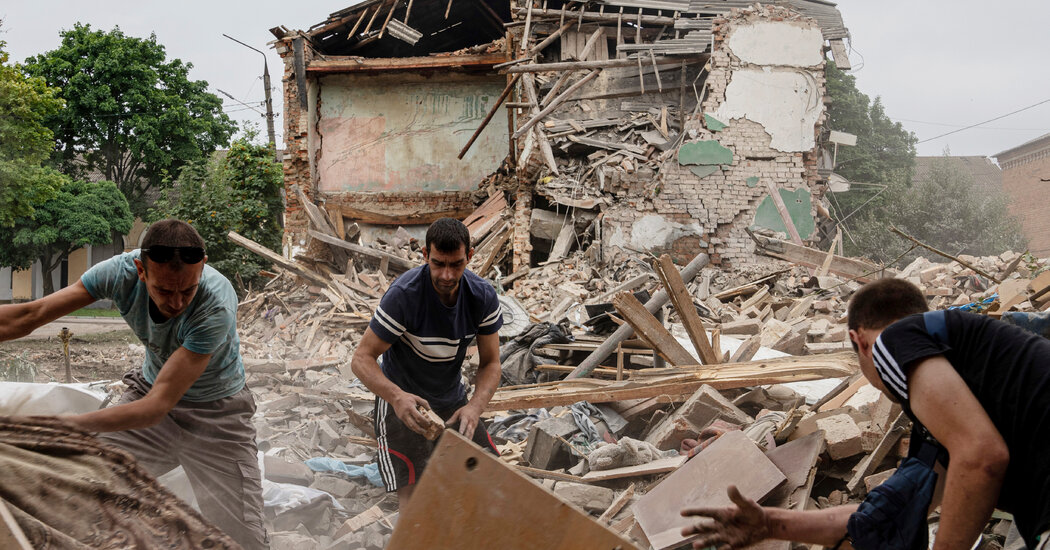
Military analysts have said for days that Russian forces have “paused” their offensive operations in the Donbas region of eastern Ukraine. But try telling that to the Ukrainian fighters under fire and dug into defensive positions in towns and villages.
Skirmishes raged in at least 10 locations in Donetsk Province, the Ukrainian authorities said on Friday, as the Russians tried to improve their positions along a fragmented front line, apparently in advance of what is expected to be a much larger military push to seize the parts of the province they do not control.
“The occupiers tried to take control of the section of the road” that runs between the cities of Bakhmut and Lysychansk, the Ukrainian general staff said in an evening bulletin that listed a host of clashes. Russian forces had also conducted “assault operations” in several other locations, including the villages of Nagirny and Bilohorivka, the bulletin said. “Ukrainian soldiers stopped all these poor attempts of the enemy with fire and pushed him back.”
Elsewhere in the province, the bulletin spoke of how Ukrainian soldiers “again successfully repelled” an assault and, in a different location, it said: “Under the fire of Ukrainian soldiers the remnants of the enemy forces retreated.” There was no immediate comment on the fighting from Moscow.
The Donbas, which is close to the Russian border that was a region of heavy industry, mining and agriculture, has been the focus of President Vladimir V. Putin’s campaign in Ukraine since Russian forces failed to capture the country’s two most important cities, Kyiv, the capital, and Kharkiv, early in the conflict. The Donbas is made up of Luhansk and Donetsk provinces.
Michael Kofman, the director of Russian studies at C.N.A., a research institute in Arlington, Va., said this week that “this is a very temporary reprieve; it’s not really an operational pause.” Speaking on the podcast “War on the Rocks,” he said Russian forces were still trying to press, “not very successfully,” on fortified Ukrainian positions around the city of Sloviansk.
He said that the next Russian advance would most likely target that city and another further south, Kramatorsk, and that the struggle for Donetsk Province could last months. He and other analysts, including Western intelligence officials, have stressed that both Russia and Ukraine have suffered heavy losses and face serious problems of manpower.
This week, U.S. officials and others familiar with the intelligence assessments estimated that, over all, about 20,000 Russians have been killed, and about 60,000 injured. Russia has tried to recruit more soldiers with offers of large cash bonuses for volunteers, Ukrainians from separatist territories, mercenaries and militarized National Guard units.
Ukraine has also been losing significant numbers of soldiers: In June, a senior government official said the country was losing as many as 100 to 200 soldiers every day.
The militaries also face equipment shortfalls. Almost a third of Russia’s equipment has been destroyed, according to Western officials, although the Kremlin retains a significant advantage in heavy weapons.
That has led Ukrainian officials to repeatedly plead for more heavy weapons and ammunition from the West, saying that they need the supplies to counter Russia’s advantage from long range. On Friday, the defense minister, Oleksii Reznikov, hailed the arrival of the first M270 Multiple Launch Rocket System, an armored vehicle that is its most advanced artillery rocket launcher.
Mr. Reznikov said the weapon would “be good company” for the U.S.-supplied High Mobility Artillery Rocket Systems or HIMARS. The U.S. has delivered eight and promised four more of the truck-mounted, multiple-rocket launchers. Ukraine’s military says it is using the ones that have arrived to strike Russian bases and depots behind the front lines.
Still, some analysts say Ukraine needs dozens more to effectively combat Russia’s artillery, and Ukrainian officials have said they need as many as 300 multiple-rocket launchers.




